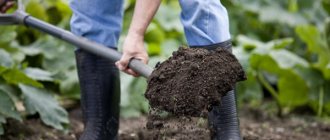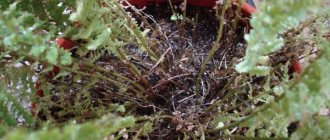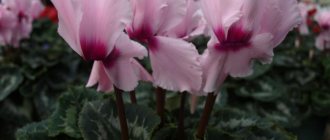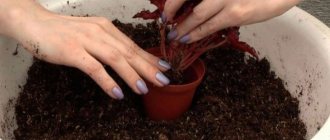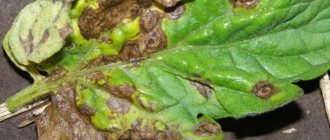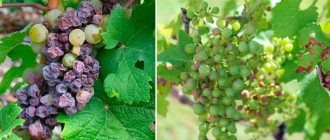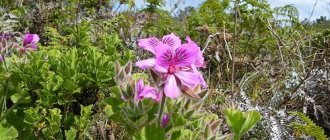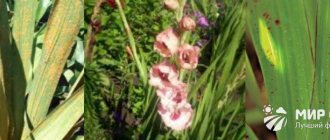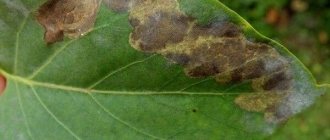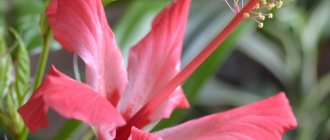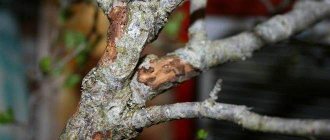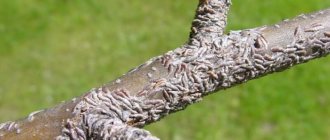Home Diseases and pests
Developing diseases of apple trees can lead to the death of an adult tree and seedling. When starting to plant a garden, you need to learn about apple tree diseases and measures to combat them in your garden plot using available means. This page contains the main diseases of apple trees that develop as a result of mechanical, physical and infectious influences. Effective struggle should not be spontaneous. Sometimes gardeners use such chemicals that the fruits cannot be eaten in the future due to the accumulation of prohibitive concentrations of toxic substances in them. It is necessary to study information about apple tree diseases and their treatment, and then apply the acquired knowledge in practice, taking into account all recommended precautions. The proposed descriptions of diseases are accompanied by images of typical symptoms. After studying the material, recognizing the problem in your garden will not be difficult. And having learned how to treat garden trees, a summer resident will be able to provide his family with a rich harvest of apples.
- 2 Diseases of the bark and trunk of apple trees and their treatment (with photographs)
- 3 Protecting the apple tree from drying out disease
- 4 Spring diseases of apple tree branches
- 5 Diseases of the trunk of apple trees: their signs and treatment (with photos)
- 6 Apple tree disease in which leaves curl
- 7 Diseases on apple tree leaves: photos, how to fight
- 8 Moniliosis - a disease of apple tree seedlings in pictures
- 9 Diseases of apple trees with curled leaves (with photos)
- 10 Diseases of the bark of young apple trees and their treatment (with photos)
- 11 Fruit diseases in apple trees: how to treat them
- 12 Non-infectious diseases of apple trees and their treatment (with video)
Lichen diseases of apple trees: description with photographs
Representatives of the genera Cladonia, Hypogymnia, Parmelia Dicranum, Mnium , etc. are common among mosses
The description of these diseases of apple trees should begin with the fact that they develop when plantings are dense, poor ventilation, poor lighting of the bushes, and conditions of high humidity are created. Such conditions are very favorable for the development of lichens and mosses, pathogenic microorganisms that cause bark necrosis, stem and root rot. Any plant covered with lichens has a sparse crown and weak growth of shoots; lichens from one tree or shrub quickly spread to neighboring ones.
The thalli of lichens retain moisture on the surface of the bark, which can cause the formation of frost holes in severe winters, and many insect pests constantly overwinter under the thalli. The spread of lichens and mosses indicates, first of all, the weakening of plants.
Seeing a description of the apple tree disease with photographs, you can arm yourself with knowledge about the potential danger and begin to fight it as recommended below.
Control measures. Constant cleaning and removal of thalli from trunks and skeletal branches and spraying plants in the fall with a solution of iron sulfate (300 g/10 l of water).
Look at the lichen diseases of apple trees in the photographs, which show the most typical symptoms:
Methods for treating apple trees for bark peeling
Damage to apple trees can be treated in two ways, both medicinally, using chemicals, and mechanically, using wood cleaning and applying medicinal dressings.
Mechanical treatment
This treatment involves completely cleaning the affected areas using a knife or other tool with a sharp cutting edge. Disinfecting liquids and mixtures are also used in treatment to completely isolate the damage from contact with the external environment.
Important! Sometimes gardeners prune diseased branches, directly removing the damaged area. It is necessary to cut out wood that appears healthy because spores of fungal diseases can infect wood at a distance exceeding 25
–
30 cm.
After each use of a cutting tool or before moving to another tree, soak the knife or pruning shears for 5 minutes in a liquid containing chlorine to disinfect. For these purposes, you can use “Whiteness,” a fabric bleaching agent.
Peeled apple tree bark.
When affected by diseases
With the mechanical method of treating an apple tree, all branches on which symptoms of disease are visible are mercilessly removed. Thick branches are cut with a garden hacksaw with fine teeth, and thin shoots are cut with garden pruners with well-sharpened blades. The sharp blades of the pruning shears ensure that the removal will take place with minimal damage to the wood, without creases. The location for truncation of the affected branch is determined as follows: it should be 30–40 cm above the detected focus of the disease.
In case of damage by animals
For extensive and serious damage to the wood shell, apply a regular garden varnish. Areas of wood damaged by animal teeth are cleared of damaged bark and a bandage is applied over a layer of garden varnish.
Read more about how to form the crown of an apple tree.
If, as a result of the disease, a large hollow has formed on the trunk, it is also cleared of dead wood, and then covered with a mixture of sand and cement. This is done to ensure that precipitation and oxygen do not get inside the hollow in the future, which can cause the onset of rotting.
In case of pest damage
Bark beetles are a very dangerous pest for fruit trees. Dense colonization of an apple tree by bark beetle leads to the undoubted death of the plant; it is impossible to cure such a tree. At the first sign of the appearance of a bark beetle in any area of the apple tree, the gardener should remove the infected branch and burn it.
Small damage resulting from the harmful activities of insects or birds is cut off with a knife to clean wood, after which the cleaned surface is treated with a thick solution of clay or any oil-based paint for wooden surfaces. After cleaning the bark, you should not use tar or products containing minerals, as they will cause additional burns to the wood and, possibly, drying out of the tree.
When temperature changes
The apple tree may develop small, long cracks in the bark. They arise due to a sharp transition from thaw to subzero temperatures. Typically, a gardener can notice such damage already with the arrival of spring. Cracks lead to peeling and falling off of the wood shell. These injuries also cannot be ignored, because in the future spores of fungal diseases may develop in these wounds or they will be occupied by insect pests.
You will be interested to know how to get rid of rotting apples.
To help the tree, the gardener must use a knife to clean off the edges of the longitudinal wound, then rub copper sulfate into the damage, and treat the damage with a thick mixture of clay and mullein or garden pitch. After treatment, the longitudinal crack is wrapped in polyethylene, which promotes rapid healing. After 30 days, the polyethylene is removed and replaced with a natural burlap bandage.
Treatment with chemicals
If the bark on the trunk has come off due to fungal diseases, the apple tree must be treated with chemicals such as fungicides. The chemical is applied not only to the damaged area, but also to the entire surface of the wood. Treatment is carried out as soon as the first signs of the disease are noticed.
For treatment with chemicals, choose a non-hot day without precipitation. If it starts to rain a few hours after the treatment, the treatment must be repeated when the raindrops have dried on the trees. Chemicals are applied to the branches of the apple tree using a garden sprayer by spraying.
Important! When starting to work with chemicals hazardous to health, the gardener must use all precautions: wear clothing that completely covers the arms and legs, a respirator, glasses and a hat.
Against bark beetle
After pests are detected, the plant is immediately chemically treated with one of the following chemicals: Confidor Extra, Calypso, Pirinex, Arrivo. It must be remembered that these drugs are insecticides and are dangerous not only for the bark beetle and its larvae, but also for bees and other beneficial insects.
A diseased tree can be treated with an organic preparation such as Bitoxibacillin, but it should be borne in mind that it has a weak effect on the pest and requires multiple treatments (at least five), with an interval of 7–10 days.
Against infections
To get rid of diseases, the surface of the tree is treated with chemicals specifically designed to fight infections.
Did you know? A small tit, flying around the garden, can eat many insects in a day, whose weight significantly exceeds its own weight.
Treatment of infectious diseases:
- Cortex cancer . It is difficult to combat this disease on an apple tree. The infection can develop at a distance of up to 30 cm from the site of infection. The main procedure to limit the development of the disease is cutting out infected shoots and controlling bark beetles. Wounds after pruning and hail should be carefully covered with garden paste; if there is a high degree of infection in the garden, they should be sprayed with fungicides. One of the most effective drugs in the fight against fruit tree cancer is the drug “Topsin M 500 SC”.
- Bark gangrene. Chemical protection against gangrene of the stem coating should be used after heavy and prolonged rains, during the period from the stage of bud emergence to fruit harvest. Mechanical damage or wounds after pruning should be treated with a paste containing the substance thiophanate, for example Funaben Plus 03 PA.
Diseases of the bark and trunk of apple trees and their treatment (with photographs)
The main diseases of the bark and trunk of apple trees are caused by fungi and are combined into a group called cancer. Further in the material, these apple tree bark diseases and their treatment are discussed with a description of the characteristic symptoms.
Common or European apple tree cancer.
The causative agent is the fungus Neonectria galligena (Bres.) Rossman & Samuels (syn. Nectria galligena Bres.). Elongated brown spots appear on the bark, which dry out and crack. Beneath them, ulcers with raised edges of callus tissue are exposed. Over the years, the ulcers increase in size and depth, and the wood gradually dies. When young plants are damaged, death occurs after 2-3 years.
On the trunks an open form of cancer is detected in the form of deep ulcers, on the branches there is often a closed form, in which the nodules grow together and a gap remains. When the disease manifests itself on a massive scale, deep ulcers also form on the skeletal branches. In the affected wood, sporulation develops along the edges of the canker in the form of whitish-cream pads that dry out and darken over time. The spores recharge neighboring branches and leaves.
Affected leaves become chlorotic, necrotic brown spots without borders appear on them, the leaves gradually dry out and fall off prematurely. Brown spots appear on the fruit on the stem side, which lead to rapid rotting. The infection persists in the affected wood and plant debris.
The disease is widespread on almost all fruit and berry crops, ornamental and deciduous tree species. With dense plantings, constant re-infection of plants is possible. The disease most often manifests itself on weakened planting material and in places of frost damage and mechanical damage to the bark of trunks and branches.
Control measures. Use healthy planting material without any necrosis of the bark and ulcers on the shoots. Compliance with all agrotechnical requirements for growing this crop. Timely pruning of affected branches with cankers and burning them. Individual ulcers in the forks of skeletal branches are disinfected with a 1% solution of copper sulfate and covered with oil paint on natural drying oil. Annual preventive spraying of plant bark before leaves bloom with Bordeaux mixture or its substitutes (HOM, Abiga-Peak).
Below is another type of apple tree bark disease with photographs in which you can see typical signs of an infectious lesion.
Black apple tree cancer.
The causative agent is the fungus Sphaeropsis malorum Berck . Black cancer often begins to develop in the forks of skeletal branches of trees. First, reddish-brown depressed spots form, then they darken, and numerous black fruiting bodies—pycnidia—appear on the bark. The affected bark turns black, becomes lumpy and resembles goose skin, over time it cracks, dries out and peels off from the wood in entire layers.
Dark brown spots appear on the leaves and fruits, similar to black rot. When trunks are affected, the disease causes trees to dry out within 1-2 years from the moment the first symptoms appear. In dense tree plantings, the disease quickly spreads from tree to tree, from apple trees to pears.
Only the damage to the bark looks a little different: the cracks along the edge are deeper, the dead bark does not turn black, but is covered with numerous cracks and crumbles easily. When the disease spreads on mature trees, it is necessary to cut out dried skeletal branches every year, which is why the tree crowns take on an ugly appearance. The infection persists in the affected bark and in affected plant debris.
Control measures. Compliance with all requirements of agricultural technology for growing fruit crops, using healthy planting material. Preventive annual spraying of trees, especially trunks and skeletal branches, with 1% Bordeaux mixture or its substitutes (HOM, Abiga-Peak). Timely pruning of dried branches, removal of dried trees, stripping of affected bark, disinfection of wounds, cuts, cuts with 1% copper sulfate and coating with oil paint on natural drying oil.
Bacterial infections
There are few bacterial diseases. But all of them are difficult to treat. If a person is treated for such an infection with antibiotics, then similar medicines for fruit trees began to be produced in the 80s of the 20th century.
The cause of a bacterial infection may be contaminated planting material. The infection is also often carried by birds - blackbirds and starlings.
Bacterial burn of branches (bacteriosis)
This disease appeared in Russia not long ago, but has already become one of the most dangerous. It is listed as a quarantine disease. The infection penetrates all parts of the tree, but flowers, ovaries and annual shoots are most affected. Bacterial activity begins at +18–20 °C and high humidity.
First, the bark becomes damp and swollen, putrefactive spots grow on the ovaries, young branches dry out, brown droplets appear on the petioles of the leaves, brown spots of dead tissue appear along the veins of the leaves.
Then the branches take on the appearance of being scorched by fire, dried foliage and fruits hang on the dead branches and do not fall off, the tops of the dried young shoots are twisted upward.
Protective actions: removal of dried branches, in this case it is necessary to cut off 20–40 cm of healthy wood, disinfection of tools with a 10% solution of copper sulfate and cuts with a 1% solution, sealing them with garden varnish. Next, spray with streptomycin. In case of a highly developed infection, the trees are uprooted, since the dried branches are not restored.
Prevention: spraying apple trees in the summer with copper-containing preparations from the moment the leaves grow until the end of June.
Bacterial cancer or cortical necrosis
In spring, the change in color of the buds to brown, followed by death, is clearly noticeable. In the spring, the bark is saturated with moisture, and in the summer it dries out and breaks. Outwardly, this disease resembles a burn; the bark seems to explode from the inside. The leaves and inflorescences dry out and do not fall off. Young shoots also dry out and curl into a sickle shape. Brown spots on the leaves are one of the signs of bark necrosis.
Protective actions: removal of affected areas, including part of healthy wood, disinfection of tools and cuts with copper sulfate.
Bacterial root cancer
Soft, smooth growths grow on the root collar and roots. Little by little they harden, grow and crack. The apple tree rots and turns black at the site of the lesion; the plant cannot develop normally and dies.
The affected tree is usually removed along with the roots, and the ground is disinfected with a 3% solution of copper sulfate.
Nowadays, new drugs have begun to be produced that can cope with bacterial infections. These are drugs that act on the basis of soil bacteria and are absolutely safe for humans.
The drugs not only have a pronounced antibacterial effect, but also fungicidal properties:
- Gamair perfectly resists powdery mildew, gray and root rot, moniliosis, scab, black leg, spotting, rust, late blight, vascular and mucous bacteriosis.
- Gaupsin is destructive to 96% of fungal infections, and also perfectly fights tobacco mosaic, bacteriosis and many insect pests.
- Fitolavin contains the antibiotic steptocide and has a bactericidal effect. For example, it treats bacterial burns. A tank mixture of Fitolovin and Abika-Peak in half doses is very effective.
In your garden you can also use fungicidal preparations:
- Fitosporin;
- Glyocladin;
- Trichodermin;
- Albin;
- Alirin B;
- Pentophage C;
- VRK.
Protecting the apple tree from drying out disease
Cytosporosis, or infectious drying of the apple tree bark.
The causative agents of this apple tree disease are the fungi Cytospora schulzeri Sacc. et Syd. (syn. C. capitata Sacc. et Schulz.) and C. carphosperma Fr. - on an apple tree, C. microspora Roberh. - on apple and pear trees. The disease is manifested by browning and death of the bark of branches, skeletal branches and trunks. Numerous convex stromas in the form of gray-brown tubercles are formed on the affected tissue.
At first they are submerged, then erupting, bluntly cone-shaped. The affected bark dries out, acquiring a finely lumpy appearance from the sporulation of the fungus, but does not peel off, but becomes wet. The fungus enters the plant through mechanical damage and spreads from the bark into the cambium and wood, causing premature drying of the branches. Fruit trees in nurseries are severely affected by dense planting and frequent pruning of the crown during the formation process. The spread of infection is facilitated by weakening of plants from exposure to low temperatures, sunburn, and mechanical damage to the bark. The infection persists in the affected branches and trunk bark and spreads when low-quality planting material is used.
Measures to protect against apple tree disease are the same as treatment methods against black cancer.
Look at the manifestations of this apple tree disease in the photo, where all the typical symptoms of bark damage are clearly visible:
Non-communicable diseases
The depressed state of the apple tree, yellowing and falling leaves, damage and death of the bark can be caused by improper tree care.
Important! An apple tree cannot be a strong and fruitful tree if it is not watered enough, does not receive enough nutrition, is overgrown with lichens, and is not protected from cold and temperature changes.
Frost and sun damage to the bark
In winter, frost often damages the bark, cambium and wood. Frost cracks form on the apple tree. Severe frosts without snow cover damage the roots of young plants and dry out the tree. In spring, the difference in day and night temperatures reaches several tens of degrees, which also causes a crack to form on the trunk of the apple tree.
Protective actions: annual autumn whitewashing protects the tree from the appearance of frost marks on the bark. Repeated whitewashing in March protects the apple tree from severe temperature changes, cracks and burns.
Lichens and mosses
Lichens often grow on old trees, and in some areas mosses. Sometimes lichens also grow on young trees, covering the growth points on young shoots with their covers.
These plants are indicators of a clean ecological situation and do not themselves harm the tree. But the bark, covered with lichen growths, becomes a breeding ground for many insects, their larvae and clutches of eggs. Areas of bark under moss thalli may rot in years with frequent rain.
Protective actions: apple tree bark must be mechanically cleaned from such plants. If this is difficult to do with gloves or a brush, you can spray the bark with a 3% solution of copper sulfate. Excess vegetation dies from the treatment, after which it is cleaned off with a metal brush.
Comber, tinder fungus
The fungus grows on diseased or drying trees, causing stem rot. As a result, the apple trees slowly dry out, becoming fragile. Mushrooms have different colors: yellowish, gray, brown. Their fruiting bodies are flat and semicircular.
Protective actions: cutting down the branches where the fungus has settled, disinfecting the cut with a 3% solution of copper sulfate. Treatment with a 1% solution of Bordeaux mixture is carried out in early spring, before the leaves grow. This prevents the growth of fungi. An indispensable procedure is whitewashing the wood.
In addition to the listed non-infectious diseases, diseases of a physiological nature may occur: glassiness, cracks, curvature and crushing of apples.
Spring diseases of apple tree branches
Spring diseases of apple trees actually develop during the winter, but their obvious signs begin to appear after the melting of the snow cover and the establishment of above-zero temperatures. The following are diseases of apple tree branches that are more common than others: their symptoms are shown and control measures are described.
Study these apple tree diseases and the fight against them using photos that richly illustrate each type of lesion:
Tubercularosis, or drying out of apple tree branches.
The causative agent is the fungus Tubercularia vulgaris Tode . Conidial stage of the fungus - Nectria cinnabarina (Tode) Fr. The disease occurs on many shrubs and deciduous trees and causes necrosis necrosis (death) of the bark. During the growing season, the leaves and shoots quickly turn brown and dry out. Numerous brick-red sporulation pads with a diameter of up to 2 mm are formed on the surface of the affected bark; over time they darken and dry out. The development of the fungus causes the death of the bark and phloem of individual branches and shoots. Often, infection of plants in gardens begins with red currant bushes, for which tubercular necrosis is the main disease. The infection persists in the bark of the affected shoots.
Control measures are the same as against ordinary cancer.
Comber.
The causative agent is the fungus Schyzophyllum commune Fr. The comb plant settles on the branches and trunks of weakened, often frozen trees and causes the development of trunk rot. It affects many fruit trees and shrubs and deciduous trees. On the affected bark, fruiting bodies are formed in the form of leathery thin caps of a grayish-white color with pronounced zonal stripes. The caps are numerous, attached sideways to the trunk or skeletal branches. As a result of the rapid spread of stem rot, the affected trees gradually dry out. The infection persists in the fruiting bodies of the fungus and in the affected wood.
Control measures. Pruning and burning of fruiting bodies, stripping wood, removing dried branches and individual trees. Disinfection of wounds and cuts with 1% copper sulfate and coating with oil paint on drying oil. Annual mandatory preventive spraying of trees before the leaves bloom, so that the drug solution wets the bark with 1% Bordeaux mixture or its substitutes (HOM, Abiga-Peak).
Why did the trunk of the apple tree turn black?
The main reasons for blackening of the apple tree trunk:
- sunburn;
- presence of sooty fungus;
- damage to black or ordinary cancer;
- growth on poor soils.
Prevention of trunk blackening:
- Apply fertilizers in a timely manner.
- Do not allow the apple tree crown to thicken.
- Periodically carry out sanitary and anti-aging pruning. Lubricate the cut areas with garden varnish.
- Carry out preventive inspections of all parts of the tree as often as possible.
How to treat a blackened apple tree trunk:
- First of all, determine what kind of disease has affected the plant.
- Remove all damaged parts of the plant (fruits, leaves, shoots, sections of bark) and burn them away from healthy plantings.
- It is also better to remove the soil in the tree trunk zone and hide it for digging in some remote place (at least 10 cm).
- The damaged areas need to be cleaned with a sharp knife (don’t forget about a 2–3 cm gap).
- Disinfect all tools after work (it is best to burn them).
- Treat cuttings with a standard gardening mixture to prevent re-infestation.
Apple tree trunk diseases: their signs and treatment (with photos)
The most common disease of the apple tree trunk is root rot, rivaled in prevalence only by scab. We invite you to find out all the necessary information about diseases of the trunk of apple trees and their treatment so that this defeat does not take you by surprise.
Root rot, or honey fungus, of apple trees.
The causative agent is the fungus Armillaria mellea (Vahl.) P. Kumm. (syn.Armillariella mellea (Vahl.) P. Karst.), causes peripheral wood rot. Honey fungus grows on the roots of living trees and shrubs, as well as on stumps.
Under the affected bark of roots, butts, bases of trunks and shoots, the fungus forms a network of black flat cords - a rhizomorph, with the help of which it actively spreads. Numerous fruiting bodies are formed on the mycelium in the form of yellow-brown caps with a stalk and a membranous ring under the cap. The fungus persists in wood, in the soil in affected plant debris, penetrates the root system of trees and shrubs, causes the death of wood roots and trunks, which is why honey fungus damage is called peripheral rot. The main signs of this disease of apple trees are visible to the naked eye: various annular spots along the entire trunk, covered with a brownish coating.
Control measures. Preventive spraying of trunks and branches with 1% Bordeaux mixture or its substitutes (HOM, Abiga-Peak). Removing and burning affected dead trees along with their roots. At the first signs of infection, the soil under the trees is spilled with a solution of a copper-containing preparation. When industrially grown in a nursery, the roots and butt part of woody plants are treated with a tank mixture: foundationol (0.2%) + HOM (0.4%).
Apple scab.
The causative agent is the fungus Venturia inaegualis Wint . with conidial stage of Fusicladium dendriticura (Wallr.) Fuck. Dark green velvety spots appear on the upper side of the leaves, gradually turning brown, the leaves turn yellow and fall off prematurely. When infected in spring and early summer, the spots are large, later, with repeated re-infections, they are small and hardly noticeable. The spores re-infect the ovaries, less often young shoots, the fruits become stained and become unfit for consumption. With the widespread spread of scab, the marketability of fruits, decorativeness and winter hardiness of trees are reduced. The development of the disease is favored by wet, cold spring and abundant rainfall in summer. The pathogen has a narrow specialization, that is, the fungus affects only the apple tree and does not spread to other trees. The infection persists in the affected plant debris.
Control measures. Collection and removal (possibly composting) of fallen affected leaves. Spraying trees, starting from the green cone phase and, if necessary, in the summer, taking into account the waiting period, with one of the preparations: 1% Bordeaux mixture, HOM, Abiga-Peak, speed, rayok. It’s easier to navigate by the phases: before flowering and immediately after flowering.
Look at these apple tree trunk diseases in the photo, which shows typical symptoms of fungal infection:
Category: Diseases of apple tree bark
It happens that spots and cracks , leaves begin to fall off prematurely, the fruits become deformed and the yield decreases. Apple tree bark diseases can cause such damage .
To help a tree get rid of a disease, it is necessary to determine the cause of the damage and use proven remedies .
That is why this article is devoted to the topic “Diseases of apple tree bark and their treatment” (photos of diseases will be presented in the appropriate sections).
Apple tree disease in which leaves curl
Powdery mildew is a disease of the apple tree in which the leaves curl and quickly dry out, and the shoots stop growing.
Look at this apple tree disease with a photo and description, it also talks about possible measures to combat fungal infection in a personal plot:
The causative agent is the fungus Podosphaera leucotricha Salm . As early as May, spots of grayish-white plaque may appear on young inflorescences and leaves, the spores of which re-infect the growing leaves and shoots. Affected leaves curl and dry out, shoots become deformed and stop growing. Affected buds do not produce fruit, and with later infection, a rusty mesh of cork tissue appears on the fruit. Powdery mildew appears more often in dense gardens or due to their low light and ventilation of the plantings. The disease is common on apple trees, but also occurs on pears, only to a mild extent. The infection persists in the fruiting bodies in the affected leaves and bark and the mycelium in the buds of the shoots, from which the primary infection of young leaves begins.
Control measures. Compliance with all requirements of agricultural technology for growing fruit crops, timely removal of heavily affected shoots from young trees, collection of fallen leaves and their composting. Preventive spraying of trees when the first symptoms of powdery mildew appear.
Powdery mildew
This disease manifests itself as grayish spots on the leaves. They contain large quantities of spores, which over time affect the entire apple tree and can spread to other trees. The affected shoots stop growing and dry out, the leaves curl. Apples on the affected tree do not develop, and over time its trunk becomes covered with a rusty net.
Like many other diseases, powdery mildew affects trees growing in poorly ventilated and densely planted areas. Usually this scourge only affects the apple tree, but sometimes it can also be found on a pear tree. The infection is tenacious and persists on removed wood.
Diseases on apple tree leaves: photos, how to fight
Diseases on apple tree leaves can be a sign of infectious, mechanical or temperature damage. You can read further on the page about how to fight fungal diseases on an apple tree that primarily affects the leaf blade.
Apple tree rust.
The causative agent is the fungus Gymnosporangium tremelloides Hartig. (syn. G. juniperinum Mart.) , affects mainly leaves, less often shoots and fruits. Orange-red round cushion-shaped spots with small black dots appear on the leaves on the upper side, and orange cone-shaped aecia are formed on the lower side, which turn brown over time. The apple tree is an intermediate host. The fungus overwinters and develops on Cossack juniper. In spring, brown growths with brown mucus appear in cracks in the bark, and the spores re-infect the leaves of the apple tree. When the disease spreads massively, the leaves turn yellow and fall off prematurely. The infection persists in juniper plantings.
Control measures. Spraying trees before flowering or immediately after it with 1% Bordeaux mixture or its substitutes (HOM, Abiga-Peak).
Brown spotting of apple leaves.
The causative agents are the fungi Phyllosticta mali Prill, et Del. and Ph. briardi sacc . When the first fungus infects the leaves, large angular dark yellow spots with a lighter center and a thin brown rim appear. When infected by the second pathogen, the spots on the leaves are round or angular, light yellow in color, without borders, up to 6 mm in diameter. Over time, small dotted black fruiting bodies of the overwintering stage are formed in the necrotic tissue. The leaves turn yellow and fall off prematurely, which affects the ripening of the wood of the shoots and their frost resistance. The infection persists in the affected fallen leaves.
Control measures. Spraying trees in the spring before flowering and immediately after flowering with 1% Bordeaux mixture or its substitutes (HOM, Abiga-Peak), collecting and removing fallen leaves.
Ascochyta blotch of apple tree.
The causative agent is the fungus Ascochyta piricola Sacc ., which affects both apple and pear trees. The spots on the leaves are round, grayish, merging with each other, and have no border. Over time, black scattered fruiting bodies of the overwintering stage are formed in the necrotic tissue. Affected leaves turn yellow prematurely and fall off. The infection persists in the affected plant debris.
Control measures are the same as against brown leaf spot.
Chlorosis of apple leaves.
Uniform yellowing of leaves between the veins is associated with a large deficiency in the supply of nutrients to young growing leaves. The reason for this may be frost damage and death of the bark or the spread of root and stem rot, as well as necrosis. With severe manifestation of chlorosis, browning and drying of leaves, dying of branches and trunks are subsequently observed.
Control measures. Timely identification of the causes of chlorosis. Preventive spraying of trees in the spring, before leaves bloom, with 1% Bordeaux mixture or its substitutes (HOM, Abiga-Peak). In case of mechanical damage and frost damage, pruning, removal of fruiting bodies of tinder fungi, all cuts and cracks are disinfected with 1% copper sulfate and covered with oil paint.
Look at these diseases on the leaves of an apple tree in the photo, where all the characteristic signs of damage are visible:
Pests
Significant damage to the crop and the health of the tree is caused by various types of pests that can live and feed on it.
Related article:
How to plant an apple tree correctly
Depending on the method of obtaining food, there are two main categories:
- sucking - aphids;
- gnawing - butterflies, caterpillars.
hawthorn
A large white and black butterfly lays eggs on leaves. Caterpillars are characterized by extreme gluttony, eating greens to a skeletal state.
Gallica
The fly lays eggs along the very edge of the leaf, and later the larvae eat them. The main characteristic of gall aphids is the curling of the plates.
Zlatka
The beetle is brown in color and lays eggs at grafting sites or in depressions in the bark. The trunk is covered with a sticky substance, the larvae make tunnels in the tissues, which leads to the death of the tree.
Goose
Another name is fruit weevil. A beetle with a long proboscis, it spends the winter in the soil. With the arrival of warmth, it eats the buds, then moves on to the ovaries and shoots. The use of Kinmiks, Inta-Vir, as well as the collection and disposal of carrion is indicated.
Mite
In the regions of the country, the following types of ticks are most often found:
- Red. The body is red in color and has a bristly covering.
- Cobwebby. The characteristic green-yellow color, which changes to a brick shade with the arrival of winter.
Related article:
Schutte disease on pine
leaf roller
Small active insects that live under leaves can often hide near the central vein. It is advisable to treat the crown and trunks with Nitrovan solution and spray with chlorophos.
Medyanitsa
A small insect that feeds on the juice of fruits and shoots. To eliminate the pest, it is necessary to use the drugs Decis and Komandor.
Ants
An invasion of ants in the spring is very dangerous - by eating the buds, they can leave the garden without a harvest. Their attack on ripening fruits is no less terrible, since, feeding on the juice of apples, they spoil them, after which they can crumble and become unsuitable for subsequent storage.
Sawfly
The female lays eggs in the flower; with the beginning of flowering, the grown larva eats the seed chamber. Later the apples fall off.
codling moth
When examining the fruit, bite marks and the caterpillar itself are clearly visible. Penetrating inside, she makes moves to get to the seed chamber of the apple.
Aphid
A dangerous insect that forms numerous colonies on the leaves. In the process of eating green mass, it covers everything around with the product of its vital activity - honeydew.
Related article:
How to fight powdery mildew on roses
An effective way to eliminate aphids is to treat dormant buds with a solution of karbofos. Recommended time: spring.
Trips
A very small insect with dimensions of 1-3 mm, characterized by high activity. They completely destroy the leaves and feed on their juice.
Khrushchik
A green beetle that eats all the pulp of the green mass. The use of various traps and the drug Nemabact is effective.
Flower beetle
The beetle is 4-5mm in size and has an elongated head. Larvae from eggs laid by females feed on flower buds. Subsequent development of buds and ovaries does not occur, which negatively affects the yield.
Gypsy moth
It poses a danger to the buds and ovaries of future fruits. One caterpillar can eat up to 35 pieces. If a clutch of eggs is detected, treatment with Verin-ENZh is necessary.
Comma-shaped scale
A small insect up to 1.5 mm in length, the main type of nutrition is the juice of leaves and fruits. To exterminate the pest, cleaning the bark with a metal brush is recommended.
Moniliosis - a disease of apple tree seedlings in pictures
Moniliosis is called a disease of apple tree seedlings, since it mainly affects young trees in the first and second years after planting. On adult plants, fresh branches not protected by bark are affected.
The causative agent is the fungus Monilia cinerea Bon. f. mali Worm, and M. fructigena Pers . The first pathogen causes a burn, in which flowers, ovaries, fruit branches and leaves turn brown and dry out, but do not fall off for a long time. The second pathogen causes fruit rot.
Rot appears in areas damaged by the codling moth. Over time, numerous gray sporulation pads in the form of concentric circles form on rotting tissue. Spores are spread by wind, rain, insects and re-infect neighboring fruits. Infected fruits mummify (dry out) and turn black. Remaining hanging on the branches, they are a source of constant infection.
Look at this apple tree disease in pictures that illustrate its gradual development with symptoms typical for each stage:
Control measures. Collecting carrion, removing mummified fruits, pruning dried branches. Spraying trees in the spring, before flowering and immediately after flowering, with 1% Bordeaux mixture or its substitutes (HOM, Abiga-Peak). In case of severe spread of monilial burn and fruit rot, a third spraying with the same preparations is carried out 10-12 days after the second spraying.
Causes and dangers of apple tree bark diseases
The tree needs bark to protect it from environmental aggression. It protects wood tissue, in which the main vital processes for the plant occur, from stress. Even minor damage to the protective layer can have a negative impact on the health of the apple tree. They become vulnerable points through which the tree is attacked by pathogenic bacteria and pests. It is important to take prompt action on any bark wounds. Including mechanical ones, the reasons for which are:
Activity of pests - insects, rodents and birds. Rodents wear away the bark from below. Bugs and birds work in tandem. The first ones gnaw holes in the wood, forming an extensive network of passages in the bark and under it. The latter, hunting insects, expand these holes. If you let a tree go, a hollow may appear on it. The most common small pests that attack an apple tree are woodworms, glass beetles, odorous woodborers and oriental codling moths. Insects are controlled using spraying and catching belts. Whitewashing the base of the trunk helps against rodents.
Lack or excess of moisture and nutrients. The bark cracks and simultaneously dries or rots.
Overload with apples, the appearance of a difference in the growth rate of the bark and inner layers of the tree. As a rule, a healthy tree copes with such problems on its own.
Cover renewal. In this case, a new, young bark will be visible under the bursting bark.
Diseases of apple trees with curled leaves (with photo)
There are diseases of apple trees with curled leaves that need to be recognized as soon as possible, since they pose a danger to other garden crops. Familiarize yourself with such diseases of apple tree leaves in the descriptions further on the page: this will allow you to quickly recognize the signs of their occurrence.
Pestalocia spot of apple tree.
The causative agent is the fungus Pestalotia malorum Elenk. et OM . The spots on the leaves are grayish-brown, round, merging. Over time, numerous black sporulation pads form on the necrotic tissue. Affected leaves turn brown and dry out prematurely. The infection persists in the affected fallen leaves.
Control measures. Spraying trees in the spring, before flowering and immediately after it, with 1% Bordeaux mixture or its substitutes (HOM, Abiga Peak), collecting and burning fallen leaves.
Tobacco necrosis virus on apple trees.
necrosis virus (TNV) manifests itself as a systemic necrotic reaction. Necrotic spots of irregular shape appear on the leaves, which become concentrated, necrotic, the veins darken, and the leaves die prematurely. Leaf deformation, plant dwarfism, and lack of flowering may occur. The virus affects vegetable, industrial, fruit and berry, flower and ornamental crops. The range of host plants includes representatives of more than 40 families. Transmitted by plant sap and zoospores of Olphidium brassicae.
Control measures. Use of healthy planting material, compliance with all requirements of agricultural technology for growing crops. Timely pruning of leaves and branches with symptoms of viral infection, removal and burning of heavily affected young trees. Disinfection of garden tools (knives, secateurs) in alcohol, cologne, 1% solution of potassium permanganate after working with affected plants.
Look at these diseases of apple tree leaves in the photo, which shows all the signs at different stages of damage:
Treatment of apple tree bark
These are diseases of weakened trees. Even experts make mistakes in diagnoses, where and what the sore is.
Take into account! Vigorous rootstocks are more resistant to such diseases; These sores are more often found on heavy, poorly prepared soils.
- Modern agricultural technology:
- Remove last year's foliage;
- Dig up the soil around the apple tree;
- Water 2-3 times per season;
- Do the trimming;
- Fertilize the apple tree with fertilizers.
If a disease is detected:
- Clean the damaged areas down to a cut of wood up to 1-2 cm thick;
- Disinfect them with copper-containing preparations;
- Cover with a solution of clay and mullein;
- Wrap in burlap;
- Repeat this after 1.5-2 months.
Diseases of the bark of young apple trees and their treatment (with photos)
Diseases of young apple trees most often have a mixed nature. They are caused by several pathogens at once. The most dangerous diseases are the bark of young apple trees, which can develop after an unsuccessful wintering. If apple tree bark disease in adulthood usually progresses slowly and the gardener has time to effectively treat it. But for young seedlings everything is different. Trees can die in a matter of days.
Next, you can learn about apple tree bark diseases and their treatment, accompanied by photos illustrating both the signs of pathology and the methods of control used:
Bacterial cancer, or bacterial necrosis, of apple bark.
The causative agent is the bacterium Pseudomonas syringae van Hall. (syn. Ps. cerasi Griffin) . Causes bacterial necrosis in both stone and pome crops. The disease resembles a burn. Since spring, browning of the buds and bark of branches, blackening and drying of young shoots and leaves have been observed. Black spots appear on the leaves, cracking along the edges of the leaf blades. The affected bark swells, swellings appear in the form of soft blisters, and depressed spots with a violet-cherry border often form.
The wood of the branches and trunks rots, a sharp sour smell of fermented sap appears, and the trees die. Bacteriosis usually begins with linear necrosis of the cortex and progresses into wide stripes. In the chronic form of cancer, ulcers form on the branches and trunks, which gradually increase in size. Gum is released abundantly from the ulcers. The affected wood turns brown and dies, and the cankers dry out. When cut, cavities filled with mucus and gum formations are visible in the wood. The infection persists in the affected branches, and the bacteria are spread by the wind, insects, pruning tools and mainly with infected planting material.
Look at the manifestations of this apple tree bark disease in the photo showing the characteristic signs of the lesion:
Control measures. Use of healthy planting material, compliance with all agrotechnical requirements for growing crops, timely removal and burning of affected branches and dried trees.
Disinfection of saw cuts, small ulcers and necrosis of bark on trunks with a solution of 1% copper sulfate and coating with oil paint. Preventive annual spraying of trees in the spring, before leaves bloom, with Bordeaux mixture or its substitutes (HOM, Abiga-Peak).
Further, diseases of young apple trees and their treatment are presented in the photo in illustrations of methods of carrying out agrotechnical measures: pruning, crown thinning, whitewashing, etc.
Diseases
Knowledge about growing apples, their requirements and care features, combined with identifying the main diseases, will bring good results. A year-round, thorough inspection of apple trees will allow you to quickly respond to any damage, and knowledge of apple tree diseases and methods of treating them will help save the crop and tree from significant damage, and in some cases, death. Below are the names, descriptions and methods of combating various diseases.
Scab
The disease is caused by the fungus Venturia inaequalis. The mycelium of the fungus overwinters on fallen leaves. It develops in winter and in spring begins to infect nearby apple and pear trees.
Symptoms of the disease:
- the first symptoms of scab are visible in mid-May; during flowering, olive-green, velvety spots appear on the leaves;
- later, rust appears on the leaves of the apple tree, the spots turn brown, the leaves dry out and fall off;
- similar spots can be seen on fruits that become small and distorted; infected fruits become deformed and fall from the tree;
- The disease can affect the stalks and petioles.
Plaque is more common on the upper side of the apple tree leaf (on the lower side of the pear leaf).
The nature of the damage depends on the susceptibility of the variety and weather conditions. Scab infestation of leaves can reach 100%, leading to a significant reduction in yield. Diseased fruits are poorly stored, wither, lose their marketable appearance, and can be colonized by pathogenic flora and rot.
Favorable conditions for the development of scab:
- high air humidity in spring, prolonged rains;
- air temperature – 16-22 degrees.
Fighting apple scab
The disease is quite difficult to treat.
- It is very important to treat apple trees against the disease in the fall before defoliation (leaf falling).
- At the stage of bud opening, they are sprayed with copper preparations: Skor, Sillit, Copper 50 WP, Bordeaux mixture.
- Then they are sprayed with the following preparations: Kaptan (Kaptan 50 WP) or Merpan (Merpan 80 WG).
You can carry out preventive spraying with Bordeaux mixture
| Processing time | Solution concentration, % |
| Along the green cone | 3-4 |
| During the bud expansion phase | 2 |
| During the summer | 1 |
Autumn spraying of apple trees with a 5% urea solution is also a very important technique. Treatment should be carried out immediately before leaf fall, when most of the leaves are still on the tree. The tree crowns and leaves that have already fallen under the trees are thoroughly sprayed. Spraying an apple tree with urea significantly reduces the risk of scab infection in the spring from fallen leaves left for the winter. As a result, the need for subsequent spraying of apple trees in the spring is reduced.
Agrotechnical preventive measures:
- raking and destroying fallen leaves;
- digging the tree trunk circle in the fall;
- crown thinning.
Photo. Fresh scab spot on a leaf
Photo. Signs of disease on apple tree leaves and young fruits.
Photo. Extensive plant infection
Anthracnose
The apple tree can be affected by the fungal disease anthracnose. The disease affects gardens mainly in the Leningrad, Samara, Kursk, Voronezh, and Pskov regions.
The causative agent is the fungus Cryptosporiopsis curvispora (synonyms Pezicula malicorticis, Gloeosporium malicorticis Cordley).
Symptoms of the disease:
- at the beginning of the disease, small round spots of brown-red color appear on the bark, around which cracks appear;
- the bark becomes brown, collapses and peels off;
- the most common symptom is elongated affected areas of the cortex;
- heavily infected trees suffer from the death of bark on the shoots;
- the bark in the infected area is clearly separated from healthy tissue, because in the infected area it is covered with dark mounds from which drops of creamy mucus flow;
- This disease can affect apple fruits, on which rotting spots appear, first small, then increasing.
In the case of young apple trees, the disease (infection of the trunk) leads to the death of the plants.
Favorable conditions
Fungal spores spread with raindrops and wind. Optimal temperature: 16-27 °C.
How to treat the disease:
- Infected parts of the plant should be removed below the affected area (the affected tree tissue is removed down to the healthy wood).
- After pruning and collecting fruits, it is worth spraying with Topsin; the wounds can be treated with Funaben Plus 03 Pa garden ointment.
Photo. Apple tree bark affected by anthracnose and an apple with signs of rot as a result of anthracnose.
Powdery mildew
This is a very harmful fungal disease, common in Central Asia, Transcaucasia, Ukraine, and Moldova. Infects apple trees in orchards and nurseries, suppressing the growth of shoots and leaves. Symptoms are visible on buds, shoots, leaves and fruits.
Although the fungus can successfully survive even at temperatures of -28 °C and -30 °C, cold winters, with frosts of -25 °C and below, significantly reduce the amount of overwintered mycelium of the pathogen. Therefore, the disease is more typical for regions with mild climates.
Problems begin already in early spring, because with the beginning of the growing season, the mycelium of the fungus, overwintering in the buds, affects young, developing tissues of growing young shoots. Young parts (leaf and flower rosettes) become infected, as a result the flowers dry out and die.
Secondary manifestations of infection occur under appropriate weather conditions. For infection by the fungus, high humidity is required - above 90% and a temperature in the range of 10-25 ° C.
Young tissues are most susceptible to this disease. Therefore, trees with intense vegetative growth, which did not complete on time, get sick more often.
Dwarf trees, characterized by low energy, in the climate of the middle zone stop growing at the turn of June and July, therefore during strong summer secondary infections of powdery mildew (July-August) they are less susceptible to infection. This is another argument in favor of growing dwarf apple trees, thanks to which you can achieve high yields, as well as reduce the likelihood of certain diseases or pest attacks (for example, aphids).
For older orchards that are producing, it is worth using proven methods to reduce tree growth, such as Regalis growth regulator, trunk or root pruning.
Symptoms of the disease:
- leaves infected with powdery mildew are covered with a white powdery coating consisting of mycelium and conidial spores of the fungus;
- the disease can affect the buds, flowers, apple fruits;
- heavily infected leaf buds often die and do not develop in the next season; less infected leaves are small, twisted, wrinkled, and have elongated petioles;
- on young annual shoots, white spots may appear on the tops, infected shoots slow down their growth, their tips often die off;
- dark spots can be seen in the plaque;
- infected flowers are poorly developed and do not bear fruit;
- First, a gray coating appears on the fruits, then a rusty mesh forms on the skin damaged by the fungus.
Photo. Signs of disease on leaves.
Photo. An apple affected by a fungus.
Control measures:
Over a long period of time, observations show that even during the powdery mildew epidemic season, gardeners cope well with the disease if they constantly provide chemical protection.
Powdery mildew control includes:
- pruning infected shoots;
- spraying with preparations: Karatan, Nimrod, Bayleton, Rubigan, Impact.
Prevention measures:
- regular watering of apple trees;
- Autumn treatment of apple trees after the leaves have fallen or in early spring includes eradicating spraying with a solution of copper or iron sulfate (2-3%).
Preventive spraying with sulfur preparations is also carried out:
- before flowering;
- after flowering;
- as needed.
Sulfur preparations effectively limit the development of powdery mildew, but it should be remembered that they only act upon contact with the pathogen and are easily washed off from plants during heavy rainfall. Some varieties of apple trees are sensitive to sulfur - such preparations can be phytotoxic in case of high temperatures and strong exposure to the sun.
Attention! Due to the nature of sulfur preparations, higher effectiveness is achieved when using lower doses, but with several spraying sessions at short intervals of 5-7 days, than with a single treatment with a high dose.
Vulnerability of varieties
When growing apple varieties that are susceptible to powdery mildew, it is necessary to treat these areas to prevent epidemics in the orchard because other less sensitive varieties will be more susceptible to the disease. Sensitive apple varieties: Idared, Cortland, Paulared, Geneva, Lodel, Jonagold group and Champion.
Photo. Young shoots affected by a white coating of the disease.
Photo. Rusted apple skin.
Brown leaf spot of apple tree (phyllosticosis)
This apple leaf disease is caused by the fungus Aposphaeria pomi (synonym Mycosphaerella pomi).
Signs of phyllosticosis:
- small brown spots appear on the leaf blades, scattered over the entire surface;
- on these spots you can see black dots, which are the fruiting bodies of fungi;
- with severe infection, the leaves fall off prematurely, the tree becomes weakened and more sensitive to frost.
Disease control includes spraying trees with preparations based on the contact fungicide Mancozeb at the beginning of the growing season and at the end of flowering, for example Dithane Neotec 75 WG or copper preparations.
The photographs show an apple leaf affected by the fungus and fallen diseased leaves.
Necrosis or bacterial cancer of the cortex
Apple trees can be affected by the phytopathogenic rod-shaped bacterium Pseudomonas syringae pv. Papulans.
Signs of this disease affecting the bark of apple trees:
- infected flowers and shoots turn brown and die in the spring;
- Necrotic spots appear on the shoots, after which thickened wounds with mucus are formed, and the branches of the tree die.
Bacterial cancer spreads from infected buds directly to the branches, then the disease affects the trunk of the apple tree, leading to necrosis of the bark. Cherry, apricot, sweet cherry, peach, apple and pear trees are especially vulnerable to this disease. As a result of infection, trees become weak, less resistant to adverse factors, and more sensitive to frost.
Fighting bacterial cancer:
- it is necessary to cut off infected plant shoots below the site of infection and protect the resulting wounds with garden ointments;
- spraying trees with preparations (for example, Miedzian 50 WP fungicide) during periods of budding, flowering and leaf fall or others: contact fungicide Nordox 75 WG, Champion 50 WP, Cuproflow 375 SC, Flowbrix 380 SC, Funguran easy 50 WP).
Photo. Dying shoots of plants.
Photo. Necrosis of the bark of the affected plant.
Common (European) cancer
Fruit tree canker, caused by the fungus Nectria galligena, is a common disease of apple trees. The disease is especially harmful in humid coastal climates. The fungus enters the tree through wounds resulting from pruning, frost damage, and broken branches. The fungus overwinters in the bark of the apple tree and enters its active phase in the spring. In summer, mushrooms multiply and are transported by wind and rain to other trees.
Symptoms:
- cancerous wounds that form on young stems, branches and annual shoots;
- in spring, dark red bumps appear around the wounds;
- the bark in diseased areas dies and falls off the tree, exposing the wood;
- a characteristic sign of fruit tree cancer is the concentric arrangement of the affected areas on the wound around the site of the primary infection, the bark falls off in concentric rings;
- Cancerous wounds develop over several years, gradually enlarging and deepening, and swellings appear along the edges of the wounds.
Prevention and control measures
Currently, there are no drugs that fight the fungus that causes this disease, so prevention is the most important in the fight against apple tree cancer.
- When pruning apple trees in early spring after cutting, you should use a garden ointment containing a fungicide to treat the wounds, such as Funaben Plus 03 PA.
- It is necessary to remove all infected shoots on which fungal spores may rest.
- In the spring, when the crowns are forming, trees are sprayed prophylactically with Topsin Topsin M 500 SC (15 ml per 5-7 l of water/100 m²).
Moniliosis of stone fruits
This disease of pome trees mainly affects apple fruit as a result of the activity of the fungus Monilinia fructigena. The disease causes great damage, especially in the southern regions.
Signs:
- the fungus enters the flower through the stigma and anthers - in early spring the flowers rapidly turn brown followed by drying (monilial burn);
- then the mycelium penetrates the fruit branch, during the summer the mycelium spreads greatly, the death of young shoots and fruit branches occurs;
- Brown and rotting spots appear on the fruits with characteristic circles of concentrated spores, most of the infected fruits fall off, and only a few remain on the trees as dried mummy.
Humid weather, daily rains, and fogs cause rapid infection. At a temperature of 20-21 degrees, conidia of the fungus germinate within a couple of hours.
Preventive measures:
- in the fall before leaf fall (when it is easier to distinguish healthy organs from diseased ones), it is necessary to carefully trim dried shoots, capturing 4-5 cm of healthy tissue;
- The fungus overwinters in dry mummified fruit remains and shoots, so mummies and infected shoots should be removed;
- it is necessary to remove contaminated plant residues and fruits, followed by burning;
- digging the tree trunk circle.
It is necessary to spray with Bordeaux mixture several times:
- in the pink bud phase of the apple tree - with a 2-3% solution;
- after flowering - 1% solution;
- 2-3 weeks after the second treatment, a third treatment is carried out with a 1% solution.
Photo. Progressive moniliosis rot is visible on apple fruits.
Photo. Fully infected fruits, the final effect is a dried mummy
Bitter rot
This dangerous fungal disease is caused by the fungi Glomerella cingulata, Colletotrichum gloeosporioides, Pezicula. The disease occurs on apples stored in warehouses and refrigerators. The disease affects ripe fruits, on which putrid, brown spots appear.
Signs of bitter apple rot:
- At the final stage of fruit storage, during ripening, numerous small spots appear.
- Over time, the spots increase in size and can merge, reaching a diameter of up to 4 cm.
- The skin on the spots is slightly sunken.
- The spots are light or dark brown with a lighter border. Numerous elevations are often found on their surface, forming clusters of conidial spores.
- Rot affects the fruit pulp, which acquires a bitter taste.
The harmfulness of the disease is very high, especially in years with high humidity and frequent rains, when the fungus spreads en masse before harvest. Losses during refrigerated storage can reach 30-50 percent.
For prevention, 2 weeks before harvesting fruits, they are sprayed with benzimidazole agents. Can be treated with Topsin M 500 SC. If necessary, two applications can be carried out, but the first application should be carried out 4 weeks before the planned apple harvest.
Photo. Stored apples infected with bitter apple rot.
milky shine
Silver leaf disease or milky leaf disease is caused by the fungus Chondrostereum purpureum. An apple tree becomes infected through open wounds resulting from injury to branches due to frost and pruning.
Signs:
- The fungus causes numerous changes on the bark, which over time becomes spotted and begins to move away from the tree.
- At the last stage of the disease, numerous fruiting bodies are found arranged in the form of tiles on the infected tree.
- Another important symptom is that in mid-summer the leaves become grayish-brown and shiny.
It is important to prevent the spread of the disease, especially since there are no fungicides to control this disease. It is necessary to remove and burn the affected leaves. Heavily infected trees also need to be removed and burned. Trees with the first symptoms must be pruned separately, and the tools must be disinfected.
Photo. Changes on the bark and silvery leaves of plants.
Photo. Fruiting bodies of a mushroom growing on an apple tree
Root collar rot or late blight
Apple trees can be affected by the fungus Phytophthora cactorum, resulting in the development of a disease called late blight. Infection occurs through wounds and cracks. The fungus attacks the root collar, the base of the tree trunk, and in the worst case, the roots.
Signs:
- as a result of infection, necrotic lesions are observed on the bark;
- then yellowing or darkening of the leaves is observed, indicating the slow death of the tree.
The fight against the disease is, first of all, prevention - growing apple trees in non-wetlands. As a preventative measure, you can use the systemic fungicide Aliette 80 WG.
Photo. Apple tree root collar rot.
Photo. Slow death of a tree as a result of damage to the apple tree trunk by late blight.
Bacterial burn
One of the most well-known bacterial diseases that can occur on an apple tree is bacterial blight of fruit crops. The disease is caused by a bacterium from the genus Ervinia - Ervinia amylovora, which affects all above-ground organs of the apple tree. The tree looks as if it has been blackened by fire and is dying. Bacterial blight of fruits is a quarantine disease.
Manifestations of the disease :
- affected leaves, flowers and shoots become brown-black, as if burned;
- the most characteristic symptoms of the disease are darkening of flowers, curved tips of young shoots in the shape of a hook;
- shoots dry out from the tops;
- the bark splits and begins to move away from healthy tissue.
Control measures
The fight must be carried out regularly, removing the infected part, which is cut back to healthy wood. If the spread is more severe, the trees will have to be uprooted and burned.
For treatments, copper preparations are used as a preventive measure twice:
- in the phase of swelling and flowering of the buds,
- during the fruit growth phase.
An example of a drug is Median (Miedzian 50 WP).
Photo. Bacterial burn of apple fruits and leaves
Fruit diseases in apple trees: how to treat them
Witches' brooms, or proliferation
These are diseases of apple fruits that damage the ovaries at the budding stage.
The causative agent is the phytoplasma Apple proliferation, Apple witch's broom . Symptoms of the disease appear in July-August. On the affected shoots of the apple tree, dormant buds wake up en masse and thin, erect side shoots with short internodes grow. The leaves are small, with short petioles and large stipules, the edges of which have sharp, atypically large teeth.
The fruits on infected branches develop small, on long stalks, flattened and tasteless. Sick trees bloom later than others, their flowers turn green and deformed, leaf buds open at a later date, and leaves turn yellow and fall off prematurely. Often, abundant root shoots develop around the trunk. Affected seedlings have a compact appearance due to reduced growth and bushiness of the tree. The disease is spread by grafting, budding, planting material and possibly seeds. In addition to the apple tree, quince is also affected. The infection persists in the affected shoots.
Recommended control measures will tell you how to treat this disease in apple trees , among which the most important is the use of healthy planting material and compliance with all requirements of agricultural technology for growing the crop. Timely pruning of branches with witches' brooms, removal and burning of heavily affected young trees. Disinfection of garden tools - knives, secateurs in alcohol, cologne, 1% solution of potassium permanganate after working with affected plants.
Scab
The leaves become covered with velvety spots, after which they begin to turn yellow and fall off. In summer, the spots are pronounced, but closer to autumn they become smaller, but this does not mean that the disease is beginning to disappear. The fruits are covered with spots that have a rough crust. It is impossible to eat them after this. The development of this scourge is facilitated by too wet weather in the spring and heavy rains in the summer months.
Only apple trees can be affected by this disease; it does not apply to other types of fruit trees. The infection persists in remote branches, so they must be burned.
Non-infectious diseases of apple trees and their treatment (with video)
Suberization of the skin of apple fruits is a non-infectious disease of the fruit. Slightly depressed brownish spots of suberized tissue appear on the fruits, and they are often slightly deformed. Late spring frosts during the flowering of gardens negatively affect the development of flowers, ovaries and young leaves. Frozen flowers and ovaries turn brown and crumble, leaves become deformed and dry out, and partially damaged fruits grow, but their skin becomes corky.
How this apple tree disease manifests itself is shown in the video, which demonstrates the most striking signs:
Control measures. If the temperature is expected to drop during the flowering of gardens, it is recommended to light fires and create a smoke screen. Young trees and shrubs can be covered with spandbond or lutrasil.
Damage to apple trees by low temperatures.
In winters with low temperatures, frequent thaws and insufficient snow, the bark, cambium, and trunk wood of fruit trees are damaged, and frost cracks appear on the trunk and skeletal branches. Solar-frost burns are observed during sharp daily temperature fluctuations, when the sun-heated bark thaws during the day and freezes again at night. Light spots of irregular shape appear on the southern and southwestern sides of the trunk. In the spring there is a slow bud opening, and in the summer there is a weak growth and drying of the shoots. At the end of summer, the bark cracks and falls off, the wood of the affected skeletal branches and trunks dies. Fungal and bacterial infections spread on weakened trees. Very often, the root system of trees freezes completely, and the affected trees dry out at the very beginning of summer.
Mechanical damage.
In most cases, branches and shoots break off under the weight of the first wet snow or heavy snow cover. In some years, branches break under the weight of fruits or strong winds. This also often happens during transportation or when planting trees, especially large ones. Therefore, in the fall, it is better to tie young plants with twine or rope and periodically shake off the snow from them. The first time after planting or transplanting, plants should be tied to a support; this will protect against bending and fractures of the trunks. Any mechanical damage and cuts of trunks and branches should be disinfected with a 1% solution of copper sulfate and covered with paint using natural drying oil. It is in the places where the wood is cut that it cracks and dies, and the trees gradually dry out.
Watch apple tree diseases and their treatment in the video, which shows the basic principles of agricultural technology and tree care at different times of the year:
- Author: admin
Rate this article:
- 5
- 4
- 3
- 2
- 1
(179 votes, average: 4.1 out of 5)
Share with your friends!
Mechanical damage
Sequence of actions for minor damage:
- Cut away any dead areas of bark.
- Spray the plant with a solution of copper sulfate (3% concentration will be sufficient).
- Lubricate the cut areas with garden varnish or make a compress from a solution of mullein and clay.
- Cover everything with a cloth to keep the compress on the trunk.
- Keep the winding moist for a month (for example, by spraying it with clean water).
